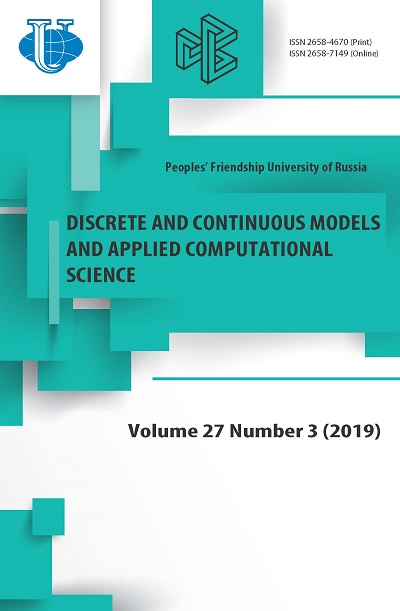Том 27, № 3 (2019)
- Год: 2019
- Статей: 8
- URL: https://journals.rudn.ru/miph/issue/view/1279
- DOI: https://doi.org/10.22363/2658-4670-2019-27-3
Весь выпуск
Математическое моделирование и вычислительная физика
Геодезическое движение вблизи самогравитирующих конфигураций скалярного поля
Аннотация
В работе изучается геодезическое движение нейтральных пробных
%частиц в пространстве-времени статических
сферически-симметричных черных дыр и голых сингулярностей, порожденных
самогравитирующим скалярным полем. Предполагается, что скалярное поле моделирует темную материю,
окружающую некоторый объект с сильным гравитационным полем,
%такой как центр нашей Галактики. Поведение времени подобных и изотропных геодезических,
проходящих очень близко к центру такой конфигурации, в решающей степени зависит от типа пространства-времени. Оказывается, что скалярно-полевая черная дыра,
подобно черной дыре Шварцшильда,
имеет последнюю устойчивую круговую орбиту и (неустойчивую) фотонную сферу, но их радиусы всегда меньше соответствующих радиусов для черной дыры Шварцшильда той же массы; кроме того, эти радиусы могут быть сколь угодно малыми. Напротив, голая сингулярность, порожденная скалярным полем, не имеет ни последней устойчивой круговой орбиты, ни фотонной сферы.
Вместо этого такая конфигурация имеет сферическую оболочку из
частиц, окружающую ее центр и все время находящуюся в квазистатическом равновесии.
Также показано, что характерные свойства изотропных геодезических вблизи центров голой синшулярности и черной дыры и черной одинаковой массы качественно различны.


О диффузии заряда в однородных молекулярных цепочках на основе анализа обобщенных частотных спектров в рамках модели Холстейна}
Аннотация
В статье приведен анализ автокорреляционных функций скорости и обобщенных частотных спектров распространения заряда в однородных последовательностях ДНК при конечной температуре. Функции рассчитаны численно в рамках квазиклассической модели Холстейна. Показано, что в системе только один параметр главным образом определяет кинетику заряда для всех последовательностей. Анализ позволил определить характер отдельных движений вносящих вклад в подвижность заряда и выделить различные режимы распространения заряда в зависимости от температуры.


Математическое моделирование
Моделирование прохождения газоконденсатной смеси через пористую среду в режиме истощения
Аннотация
Одной из важных задач при разработке газоконденсатных месторождений является минимизация потерь извлекаемых углеводородов, возникающих из-за конденсации газа в порах пласта. Поиск оптимальных режимов газодобычи производится как на основе лабораторных экспериментов, так и на основе компьютерного моделирования. В этой связи актуальность приобретает верификация построенных математических моделей на основе сопоставления расчётных данных с данными, полученными в ходе экспериментов на лабораторной модели пласта. В рамках классического подхода, основанного на законе Дарси и законе неразрывности потоков, сформулирована модель, описывающая прохождение многокомпонентной газоконденсатной смеси через пористую среду в режиме истощения. Численное решение соответствующей системы нелинейных уравнений в частных производных реализовано на основе комбинированного применения С++ и Maple. Показано, что используемый подход обеспечивает количественное согласие полученных численных результатов с экспериментальными данными, полученными в ВНИИГАЗ (г. Ухта), по динамике извлекаемости углеводородов в зависимости от давления.
 205-216
205-216


О диффузии заряда в однородных молекулярных цепочках на основе анализа обобщенных частотных спектров в рамках модели Холстейна
Аннотация
 217-230
217-230


Геодезическое движение вблизи самогравитирующих конфигураций скалярного поля
Аннотация
В работе изучается геодезическое движение нейтральных пробных частиц в пространстве-времени статических сферически-симметричных чёрных дыр и голых сингулярностей, порождённых самогравитирующим скалярным полем. Предполагается, что скалярное поле моделирует тёмную материю, окружающую некоторый объект с сильным гравитационным полем, такой как центр нашей Галактики. Поведение времениподобных и изотропных геодезических, проходящих очень близко к центру такой конфигурации, в решающей степени зависит от типа пространства-времени. Оказывается, что скалярно-полевая чёрная дыра, подобно чёрной дыре Шварцшильда, имеет последнюю устойчивую круговую орбиту и (неустойчивую) фотонную сферу, но их радиусы всегда меньше соответствующих радиусов для чёрной дыры Шварцшильда той же массы; кроме того, эти радиусы могут быть сколь угодно малыми. Напротив, голая сингулярность, порождённая скалярным полем, не имеет ни последней устойчивой круговой орбиты, ни фотонной сферы. Вместо этого такая конфигурация имеет сферическую оболочку из частиц, окружающую её центр и всё время находящуюся в квазистатическом равновесии. Также показано, что характерные свойства изотропных геодезических вблизи центра скалярного поля голой сингулярности и центра скалярного поля чёрной дыры, имеющих одинаковую массу качественно различны.
 231-241
231-241


Моделирование прохождения газоконденсатной смеси через пористую среду в режиме истощения
Аннотация
Цель: Одной из важных задач при разработке газоконденсатных месторождений является минимизация потерь извлекаемых углеводородов, возникающих из-за конденсации газа в порах пласта. Поиск оптимальных режимов газодобычи производится как на основе лабораторных экспериментов, так и на основе компьютерного моделирования. В этой связи актуальность приобретает верификация построенных математических моделей на основе сопоставления расчетных данных с данными, полученными в ходе экспериментов на лабораторной модели пласта.
Методы: Для моделирования прохождения многокомпонентной газоконденсатной смеси через пористую среду в режиме истощения формулируется начально-граничная задача для системы нелинейных уравнений в частных производных. Ее численное решение реализовано на основе комбинированного применения С++ и Maple.
Результаты: В рамках классического подхода, основанного на законе Дарси и законе неразрывности потоков сформулирована модель, описывающая прохождение многокомпонентной газоконденсатной смеси через пористую среду в режиме истощения. Показано, что используемый подход обеспечивает количественное согласие полученных численных результатов с экспериментальными данными по динамике извлекаемости углеводородов в зависимости от давления, полученными в ВНИИГАЗ (Ухта).
Выводы: Подтвердилась эффективность разработанного подхода и возможность его дальнейшего использования.


Численное и имитационное моделирование
О свойствах численных решений динамических систем, полученных по схеме средней точки
Аннотация
В статье рассматривается схема средней точки как разностная схема для динамической системы вида ̇ = (). Эта схема замечательна тем, что в силу теоремы Купера сохраняет все квадратичные интегралы движения, более того, это - простейшая схема из числа симплектических схем Рунге-Кутты, обладающих названным свойством. Свойства приближённых решений изучены в рамках численных экспериментов с линейным и нелинейным осцилляторами, а также с системой нескольких связанных осцилляторов. Показано, что помимо сохранения всех интегралов движения, приближённые решения наследуют периодичность движения. При этом уделено внимание обсуждению введения понятие периодичности приближённого решения, найденного по разностной схеме. В случае нелинейного осциллятора выполнение каждого шага требует решения системы нелинейных алгебраических уравнений. Обсуждены вопросы организации вычислений по таким схемам. Дано сравнение с другими схемами, в том числе симметрическими относительно перестановки и .̂
 242-262
242-262


Вычислительный эксперимент в эпоху HPC
Аннотация
В данной заметке обсуждается влияние развития архитектуры и технологии параллельных вычислений на цикл вычислительного эксперимента. В частности, делается вывод, что разработка и установка высокопроизводительных вычислительных систем действительно важна сама по себе, вне зависимости от конкретных научных задач, поскольку наличие современных высокопроизводительных вычислительных систем в академической инфраструктуры даёт широкие возможности и стимулирует новые исследования.
 263-267
263-267
















